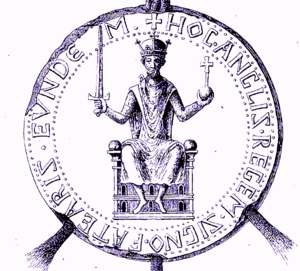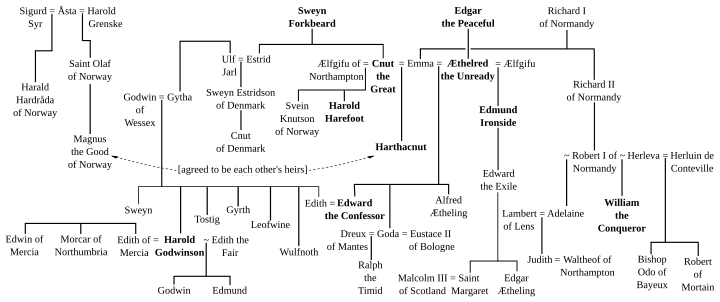Danish attacks on Norman England facts for kids
After William the Conqueror took over England in 1066, the country faced several challenges. One big challenge came from Denmark. The Danish kings believed they had a right to the English throne. This was because Cnut the Great, a famous Danish king, had once ruled England.
There were two main Danish attacks on Norman England. The first was a large invasion in 1069–1070. The Danes teamed up with English rebels. They managed to capture York and then Ely. However, they eventually accepted money from William to leave England. The second attack was a big raid in 1075. This raid aimed to help a rebellion by some English earls. During this raid, the Danes attacked the coast of Lincolnshire and the city of York. A third attack was planned for 1085. A huge fleet of ships from Denmark, Flanders, and Norway was gathered. But this invasion never happened.
None of these Danish attacks succeeded in taking the English throne. The Danes mostly gained some valuable items and money.
Contents
Why Did the Danes Attack England?
Sweyn Estridson was the nephew of Cnut the Great. Cnut had ruled a large empire that included England, Denmark, and Norway. Sweyn believed he had a claim to the English throne. He even said that Edward the Confessor, an earlier English king, had promised him the throne.
For many years, Sweyn was busy fighting wars in Denmark. He was trying to secure his own kingdom. He didn't have time to focus on England until 1064. When Edward the Confessor died in 1066, Sweyn didn't immediately try to claim the throne.
Some sources say that Tostig Godwinson, the brother of the new English king Harold Godwinson, asked Sweyn for help. But Sweyn didn't get involved. William, Duke of Normandy, even sent a message to Denmark. He wanted to make sure Sweyn would stay neutral if he tried to take England. Sweyn seemed to agree.
After William became king, some English leaders asked Sweyn for help. They wanted him to fight against William. Sweyn didn't act right away. But William still saw him as a dangerous threat to his new rule.
The Great Invasion of 1069–1070

In January 1069, a rebellion started in Northumbria. The new earl, Robert de Comines, and his men were attacked and killed. The Northumbrians again asked Sweyn for help. William sent a messenger to Denmark to try and stop Sweyn. English people who had left the country came back to join the rebels. But William quickly went north and defeated them near York. Then he returned to the south.
In August 1069, Sweyn finally launched his invasion fleet. It was a huge fleet, with estimates of 240 to 300 ships. The army included soldiers from Denmark, Norway, and other parts of Europe. Sweyn's sons, Harald and Cnut, led the army.
The fleet sailed along the North Sea coast. They tried to land in Kent at Dover and Sandwich, but they were pushed back. They managed to land at Ipswich, but local forces made them retreat to their ships. They also failed at Norwich.
Finally, the Danes sailed to the Humber river. They landed successfully there. Many English leaders joined them, including Waltheof and Edgar Ætheling, who also claimed the throne. The Anglo-Saxon Chronicle says that "all the people of the country" joined them. This means there was a big uprising in Yorkshire. The combined army marched on York with high spirits. They defeated the Norman soldiers in York's two castles and took the city.
William was far away when he heard about the Danish landing. He quickly marched his army north. When the Danes heard William was coming, they left York. They either went back to their ships or set up defenses along the rivers. William's army cleared out some Danish forces. He crossed the River Aire and by Christmas, he had taken back York.
After Christmas, William began a harsh campaign in the northern areas. This was called the Harrying of the North. It caused a lot of destruction. Meanwhile, the Danes made a deal with William. They would leave England in the spring. In return, William would give them a large payment. They were also allowed to take food and supplies from the eastern coast.
In the spring of 1070, Sweyn Estridson himself joined the fleet. He sailed it to the Wash. From there, his army marched to the Isle of Ely. The Anglo-Saxon Chronicle says that "Englishmen from all the fenlands came to meet them." They thought the Danes would help them win back the whole country. Among these English fighters was Hereward the Wake, a local leader. He led his men in attacking Peterborough Abbey.
In the summer, Sweyn and William made another agreement. The exact terms are not known, but it likely included another payment. After this, Sweyn returned to Denmark.
The Raid of 1075
In 1075, three powerful earls planned a rebellion against King William. They were Ralph de Gael, Roger de Breteuil, 2nd Earl of Hereford, and Waltheof. Waltheof had been part of the 1069 rebellion but had been forgiven. They sent messages to Denmark asking for help.
William was in Normandy when the rebellion started. But his trusted advisor, Lanfranc, the Archbishop of Canterbury, and other loyal earls quickly stopped the rebellion.
A Danish fleet of 200 ships arrived in Norfolk. It was led by Sweyn's son Cnut and another earl named Hakon. But they arrived too late to help the rebellious earls. The fleet then sailed north. They attacked towns along the Lincolnshire coast and sacked York. After that, they turned south again and headed for Flanders. The Danish leaders probably realized their force was too small to achieve anything more without English help.
Invasion Plans of 1085–1086
Sweyn's son Cnut, who had led attacks in 1069 and 1075, became king of Denmark as Cnut IV. By 1085, he had formed an alliance with Robert I, Count of Flanders and Olaf III, king of Norway. Their plan was to work together to invade England.
According to one writer, the combined invasion fleet was huge. It had 1000 ships from Denmark, 600 from Flanders, and 60 from Norway. This was much larger than the earlier fleets. William didn't have a strong navy to stop them from landing.
Instead, William brought many soldiers from other parts of Europe. He placed them in the eastern coastal areas and even further inland. The Anglo-Saxon Chronicle says that William ordered the coastal areas to be destroyed. This was so that if his enemies landed, they would find nothing useful to take quickly. However, other historical records don't show much evidence of this destruction.
One writer even claimed that William ordered Englishmen to dress and arm themselves like Frenchmen. This was to confuse the invaders. But on the other side of the North Sea, King Cnut had other problems. He had to deal with a rebellious brother and attacks from the Holy Roman Empire.
By the spring of 1086, William must have felt the danger was over. He sent his army home. In July 1086, Cnut was killed by rebels in Denmark. This finally ended the threat of a Danish invasion. This was probably the last time England faced such a big threat from Denmark. Some historians believe this crisis made William strengthen his power. He made his important subjects swear loyalty to him. He also started the Domesday Book survey to understand his kingdom's resources better.
Later Danish Claims
The Danish kings didn't give up their claim to the English throne right away. They brought it up occasionally through the 1100s. One writer even claimed that King Eric III attacked England's borders in 1138. But no English or Danish historical sources mention such an attack. Most modern historians think this was a mistake or confusion with other events.
In the 1170s, a writer named Richard FitzNeal mentioned that the Danish claim still existed. In 1193, the French king, Philip II, married a Danish princess. Some believed he wanted to inherit her rights to the English throne. As late as 1206, the Danes still hoped to reclaim England, according to one source.
In 1240, a writer named Matthew Paris wrote that "rumours abounded in England that the Danes were preparing to invade the kingdom." However, these fears were probably not true. There is no other evidence that Valdemar II, the Danish king at the time, had an invasion fleet. These rumors likely came from English worries about their own king, Henry III, who seemed weak against foreign threats.


